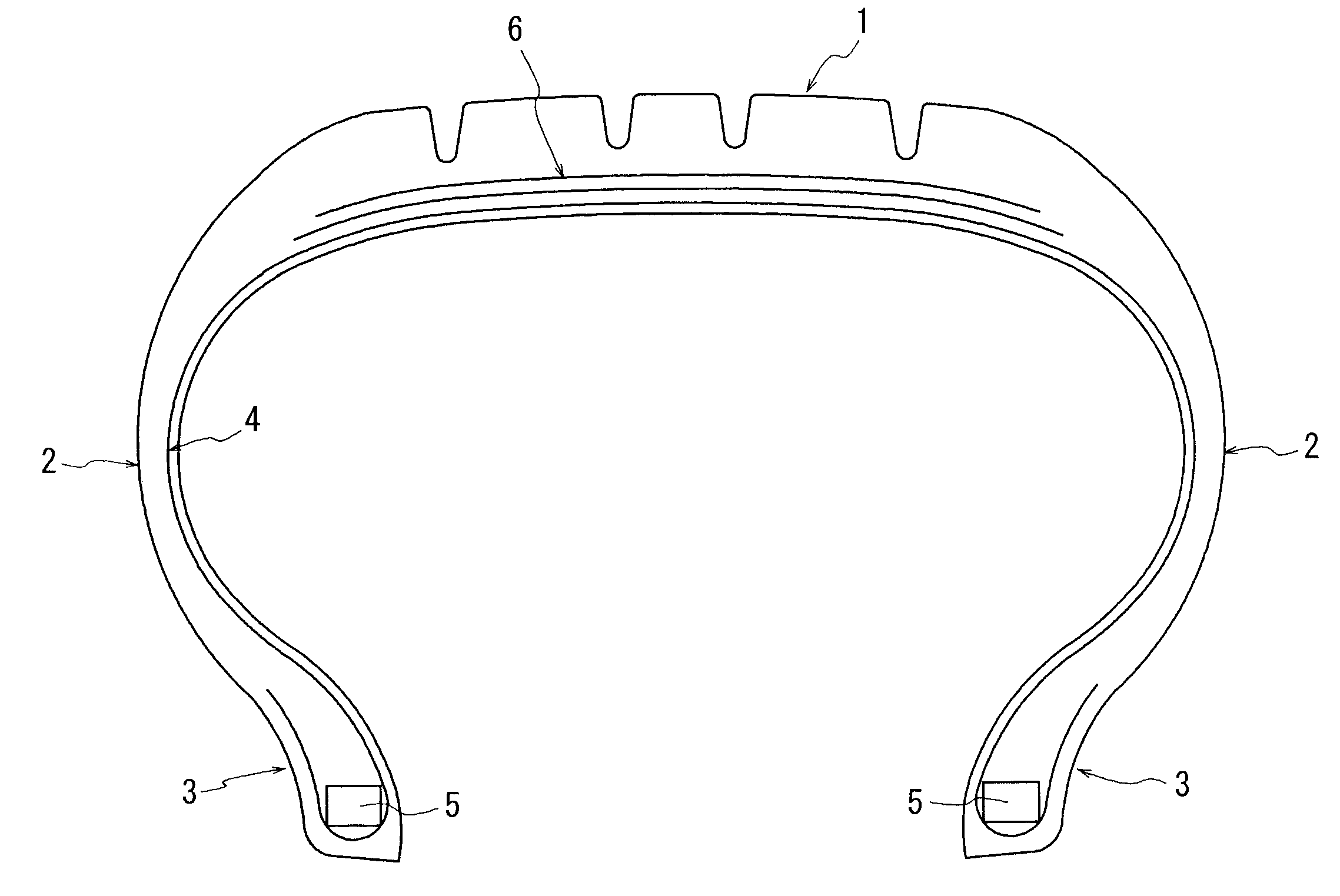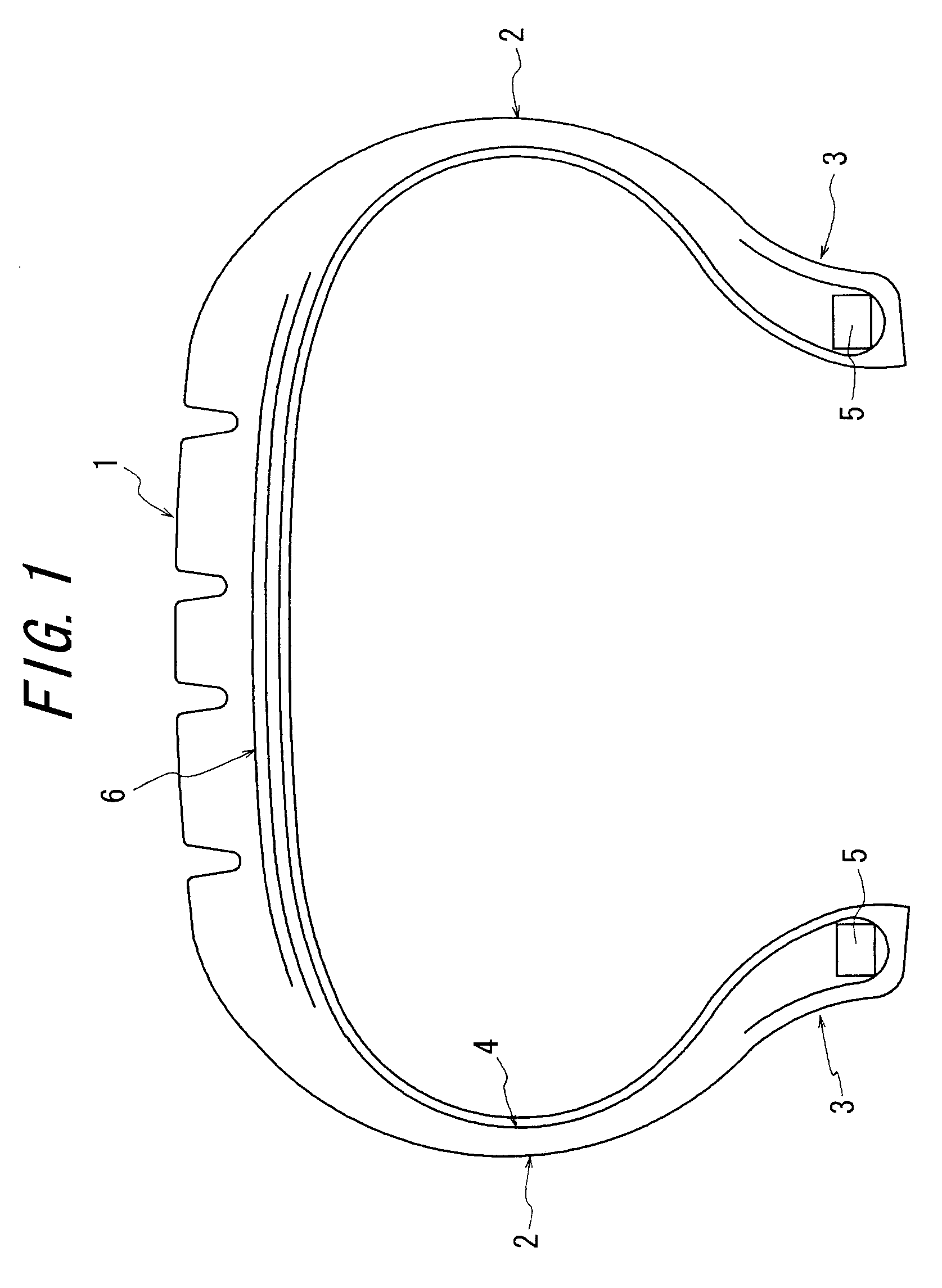Pneumatic tire
a pneumatic tire and rubber technology, applied in the field of pneumatic tires, can solve the problems of poor compatibility with rubber, high polarity of resorcin or rf resin, insufficient resistance to humidity aged adhesion between steel cords and coating rubbers, etc., and achieve the effects of reducing productivity, deteriorating drawability, and insufficient adhesion
- Summary
- Abstract
- Description
- Claims
- Application Information
AI Technical Summary
Benefits of technology
Problems solved by technology
Method used
Image
Examples
production example 1
[0072]A solution of 330.6 g (3.0 mol) of resorcin dissolved in 600.0 g of pyridine is placed on an ice bath below 15° C. and 54.9 g (0.30 mol) of adipoyl chloride is added dropwise thereto. After the completion of the addition, the resulting reaction mixture is raised to room temperature and left to stand over whole day and night to complete the reaction. From the reaction mixture is distilled off pyridine under a reduced pressure, and the residue is added with 1200 g of water and cooled on ice to obtain precipitates. The precipitates are filtered, washed with water and dried under a reduced pressure to obtain 84 g of white-light yellowish powder. The powder is treated through a liquid chromatography provided with a preparative apparatus under the following conditions to dispense an elutant containing main components. The elutant is concentrated and the precipitated crystal is recovered by filtration and dried under a reduced pressure to obtain a crystal having a melting point of 14...
production example 2
[0087]As a result of analysis on 84 g of a powder obtained by the same reaction as in Production Example 1 through HPLC, bis(3-hydroxyphenyl) adipate in the powder is 89% by mass. This powder contains compounds represented by the following formula (VIII) (which may be called as an oligomer hereinafter), in which a compound of n=2 is 7% by mass and a compound of n=3 is 2% by mass, and 2% by mass of resorcin as a starting material. Moreover, the identification of the compound represented by the formula (VIII) is carried out by LC-MS.
[0088]The measuring conditions of MS spectrum are as follows.
[0089]Mass range: 200-2000 amu (1.98+0.02 sec)
[0090]Ionization process: ESI (electrospray)
[0091]Mode: positive
[0092]Capillary: 3.15 kV
[0093]Cone: 35 V
[0094]S.B. Temp.: 150° C.
[0095]Deslv. tmp: 400° C.
[0096]Multi: 650 V
[0097]N2: 750 L / hr
[0098]n=2: 551.1[M;H]+, 568.2[M+H]+
[0099]n=3: 771.2[M+H]+, 788.2[M+H]+
[0100]n=4: 1008.3[M+H]+
[0101]n=5: 1228.3[M+H]+
[0102]Also, the analytical conditions of HPLC a...
production example 3
[0113]The same procedure as in Production Example 1 is repeated except that resorcin is 176.2 g (1.6 mol) and pyridine is 400 g and adipoyl chloride is 73.2 g (0.40 mol) to obtain 118.6 g of a powder. As a result of HPLC analysis, this powder contains 73.4% by mass of bis(3-hydroxyphenyl) adipate, 13.9% by mass of the compound of n=2 in the formula (VIII), 3.0% by mass of the compound of n=3 in the formula (VIII), 0.8% by mass of the compound of n=4 in the formula (VIII), 0.2% by mass of the compound of n=5 in the formula (VIII) and 2.9% by mass of resorcin as a starting material.
PUM
| Property | Measurement | Unit |
|---|---|---|
| depth | aaaaa | aaaaa |
| carbon number | aaaaa | aaaaa |
| reaction temperature | aaaaa | aaaaa |
Abstract
Description
Claims
Application Information
 Login to View More
Login to View More - R&D
- Intellectual Property
- Life Sciences
- Materials
- Tech Scout
- Unparalleled Data Quality
- Higher Quality Content
- 60% Fewer Hallucinations
Browse by: Latest US Patents, China's latest patents, Technical Efficacy Thesaurus, Application Domain, Technology Topic, Popular Technical Reports.
© 2025 PatSnap. All rights reserved.Legal|Privacy policy|Modern Slavery Act Transparency Statement|Sitemap|About US| Contact US: help@patsnap.com



